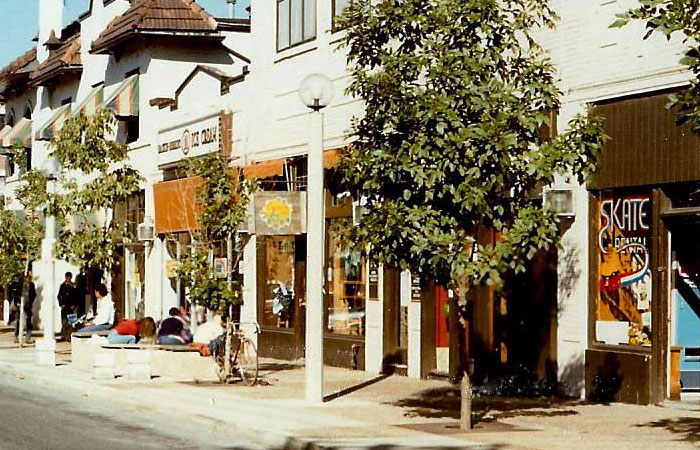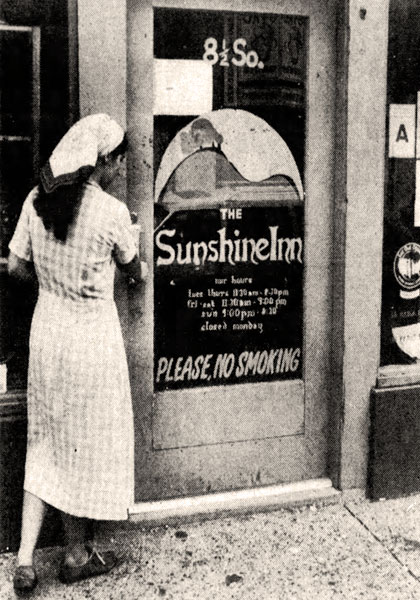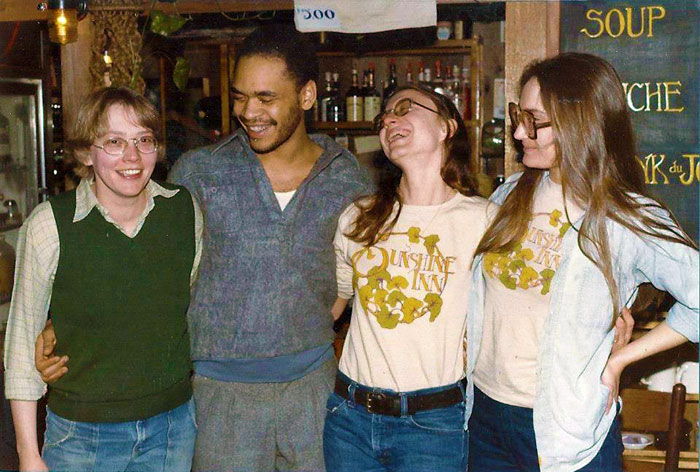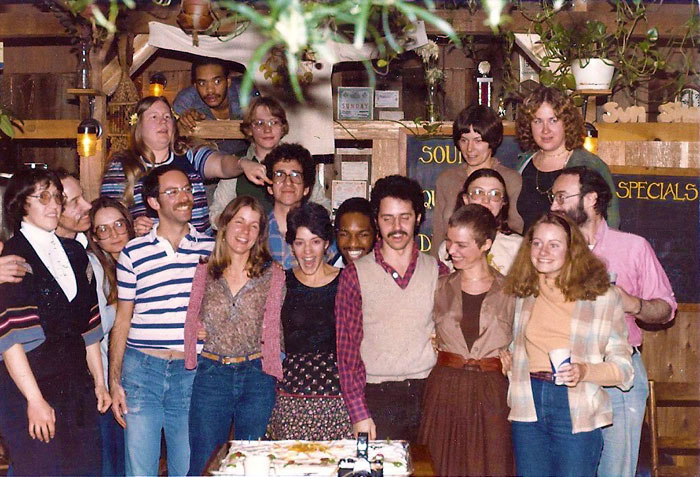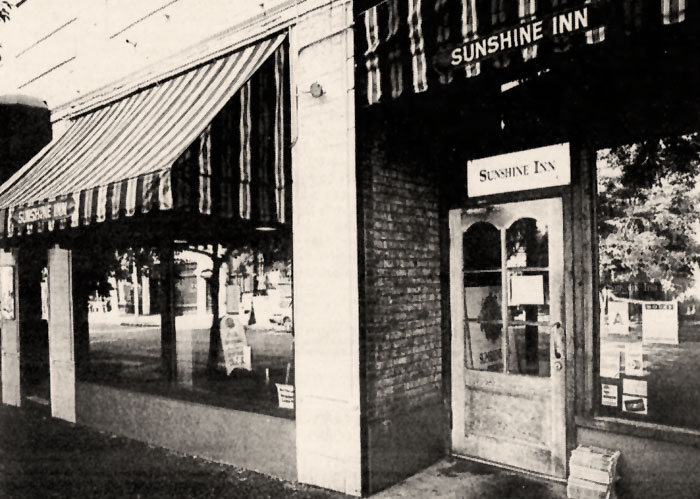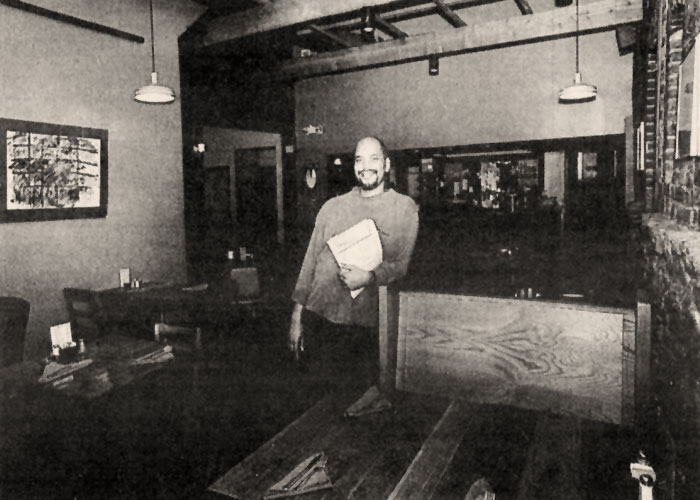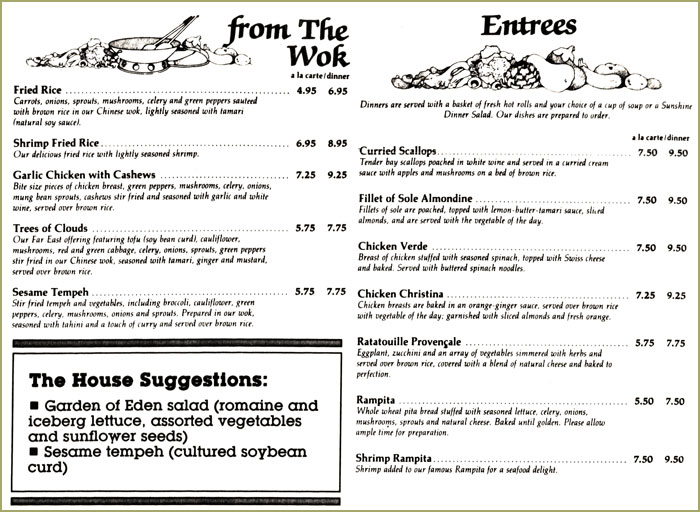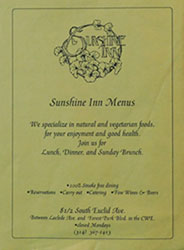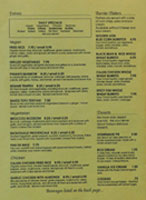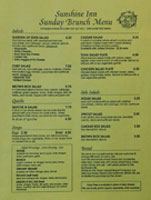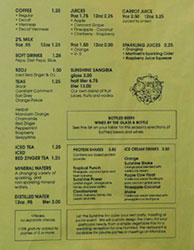|
Sunshine Inn
On Valentine's Day of 1974, Woody Lord opened a
vegetarian restaurant at 8˝ South Euclid in the Central West End,
next to the Baskin-Robbins. He called it the Sunshine Inn.
The space was small, with only 12 tables. There was little waiting area. Rough wooden walls were dotted with photographs, and there was an abundance of greenery. The restaurant had a peace-and-love atmosphere, with an eclectic clientele that ranged from writers to hippies. The Sunshine Inn started out hardcore vegetarian – no meat, no liquor, no coffee. At the time, it was the only vegetarian restaurant in town. Their belief in health and natural foods was summed up on their menu.
The menu listed a wide variety of dishes, although not all were available on a given day; available choices were scribbled on a blackboard. There were soups, salads, sandwiches, vegetarian entrees and Chinese stir-fried vegetables, plus a handful of desserts. Celestial soup boasted fresh vegetables in a clear broth; a cold cucumber-yogurt soup included fresh radishes and green pepper. The Garden of Eden salad became a Sunshine Inn mainstay, loaded with leaf and romaine lettuce, red cabbage, cucumbers, carrots, radishes, sprouts, tomatoes, red onions and sunflower seeds. It was topped with mozzarella cheese, white cheddar or tofu. The Spring Snow sandwich was composed of cream cheese, olives, celery, chives and bean sprouts. The Golden Lion, a grain-and-vegetable patty served on a wheat bun with melted cheese, sliced tomato, sliced red onion and alfalfa sprouts, became the Sunshine Inn’s best-selling dish. Their tongue-in-cheek menu joked that "over 1 billion" had been served. Entrees included Pease Porridge Hot, a vegetarian stew of mung beans, lentils, split peas, peanuts, barley and rice, and Prairie Golden-Aster, a casserole of broccoli, Brussels sprouts, mushrooms, onions, eggs and cheese. Bread, salad dressings, desserts and many other items were made on the premises and contained no sugar, artificial flavors, color or preservatives. Honey and maple sugar were used to flavor desserts. The carrot cake was a favorite. It was tangy, spicy and sweet, with a cream cheese-honey icing. The Sunshine Inn was one of the first restaurants in St Louis to ban smoking; PLEASE NO SMOKING was painted in blue on the front door.
"The nonsmokers really love our policy,"
explained owner Woody Lord. "I know we've lost business
due to the policy, but we're trying to create a healthy as well as
pleasant atmosphere."
In 1975, after owning and operating his vegetarian restaurant for only a year, Woody Lord decided to pursue other interests and gave the Sunshine Inn to his employees. The employee group ran the Sunshine Inn as a collective for two years. "It seemed like a good idea when we started out with a group of people dedicated to operating the restaurant collectively," said Rudy Nickens, one of the group. "It was funny – trying to make collective decisions about whether to put the sesame oil on the salad before the cheese or whatever. It was fun, but deadly." In 1977, all but four of the members of the collective dropped out, and the remaining four – Martha McBroom, Grundl Rundle, Sharon Wilier and Rudy (Atiba) Nickens – formed a partnership to own and manage the restaurant.
"We just wanted to make a go of the business,
rather than see it close," said McBroom. "And doing that has
been fun. But strange as it may seem, we weren't motivated by
profit. It was more a desire to stay and work together, serving our
customers a bill of fare we think is unique."
In the summer of 1978, the restaurant closed for renovation. The new partnership spent $10,000 remodeling the rented quarters and obtained a liquor license. They expanded the menu but kept popular vegetarian items. "We thought we needed to appeal to more people," explained Rudy Nickens. "When we reopened, we stocked a bar, bought ashtrays, and added seafood, poultry and beef dishes to the menu." Nickens had moved to St. Louis from Washington, D.C. in 1973 to attend Washington University. In 1976, he left the university to work at the Sunshine Inn.
"I walked in and knew I wanted to be a part of
it," Nickens said. "We were just a bunch of free-thinking,
interested visionaries. Some call them hippies — I call them smart
people. The core staff was there for twenty years."
Business at the renovated restaurant was good. "Our type of restaurant is benefiting from an increasing demand for natural foods across the country, which now is being reflected in the St. Louis area. And we're happy about that," explained McBroom. Profits were more problematical – lower than the industry average. But while the partners would have liked to earn more and pay their employees better, they weren't dissatisfied. "We manage to support ourselves," Nickens said.
In mid March of 1984, the Sunshine Inn reopened
after a second renovation, this time doubling in size. What was a
modest 8˝ became 8˝, 12 and 12˝ on South Euclid. Rudy Nickens and
Martha McBroom were now the sole owners and their expansion was
financed by a $300,000 loan from the Small Business Administration.
Twice as many people could eat at the expanded
restaurant and customers could now wait for tables in a pleasant
entry hall of exposed brick and stone. Just beyond the entry was the
new dining room, which reflected the same natural warmth and
comfortable atmosphere of the original dining room next door. Both
rooms were furnished with simple wooden booths. Green plants and
fans hung from cedar grids on the ceiling.
"We've been overwhelmed by all the people who have come through here since we reopened. It's great." said Nickens, whose job was to train cooks and supervise the kitchen. "I've been cooking, too; working full time in the kitchen to try to keep up," he said. "But that's OK. I've got a real kitchen this time, a big kitchen, and it's no longer the walkway to the rest rooms."
The restaurant
continued to specialize in vegetarian and natural foods. Seafood
and poultry dishes were still on the menu, but red meat was no
longer served.
Campaigns and movements were launched from the
Sunshine Inn. The city's first black mayor, Freeman Bosley Jr., held
fundraisers there. Author Frances Moore spoke about her vegetarian
call to arms, Diet for a Small Planet. The restaurant's patrons continued to be a convivial mixed group. Doctors and nurses from the local hospitals dined next to competitive body-builders and aerobics instructors from the area, many of whom parked their bicycles outside. Actress Susan Sarandon frequented the restaurant while shooting the movie White Palace, no doubt seeking relief from the film’s setting in a burger joint. Even diehard carnivores seem to enjoy eating at the Sunshine Inn for a change of pace, especially at weekend brunches. The brunch menu featured omelets, multigrain pancakes, quiches, scrambled tofu and home-fried potatoes, in addition to standard luncheon items.
As the Sunshine Inn
moved through the 1990s, menu offerings returned to their original
vegetarian roots, scaling back on chicken and fish dishes. "It's a
nice feeling to know that people come here, and keep coming here,
for what we like to serve," Nickens said. The Sunshine Inn was forced to close in April of 1998. "The building was bought by a new owner about two years before we closed it," Nickens recalled. "The new owner had a different vision for what to have there and raised the rent tremendously. We couldn’t negotiate good terms, so we closed it.
"We had spent the six months before we closed
grieving. I remember that last day we were open. I cooked and I
worked the line. I got there really early and did all the prep work
and fixed breakfast for the staff. I didn’t want them to have to do
anything. And then I cooked and cried all day long."
You can hear Martha McBroom and Rudy Nickens tell the story of the Sunshine Inn in the Lost Tables Podcast Series.
Copyright © 2024 LostTables.com |


